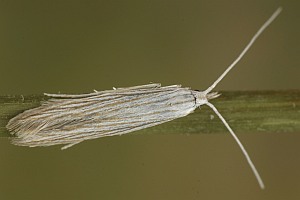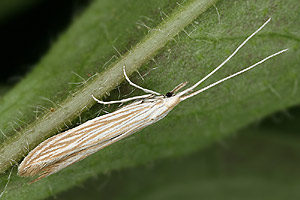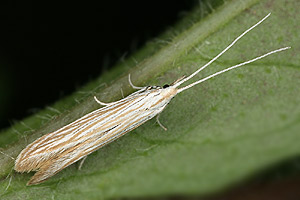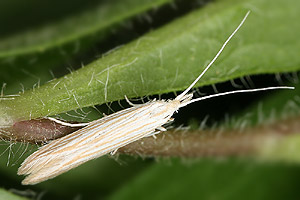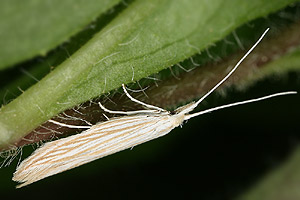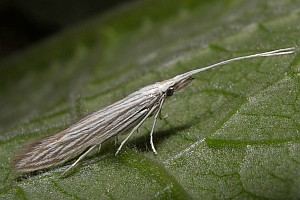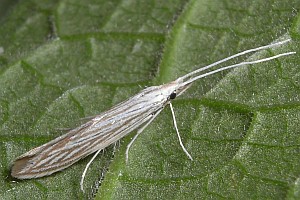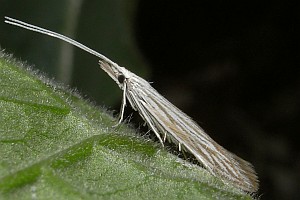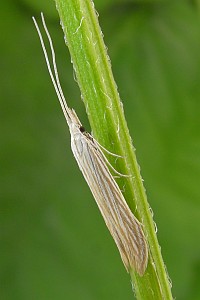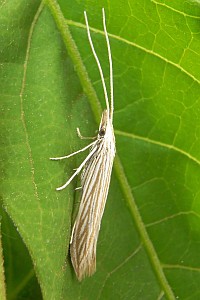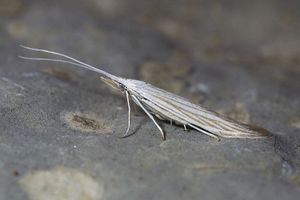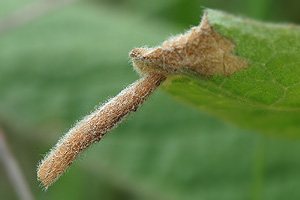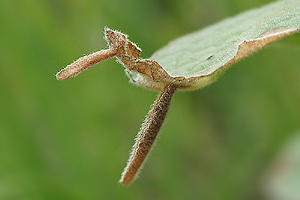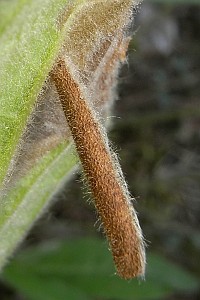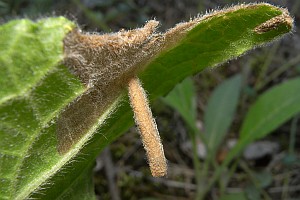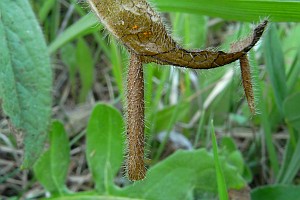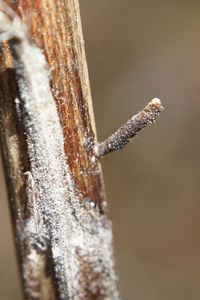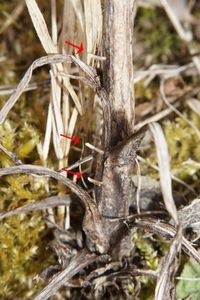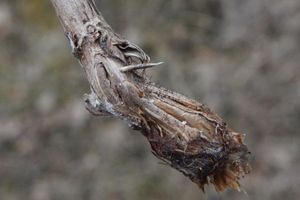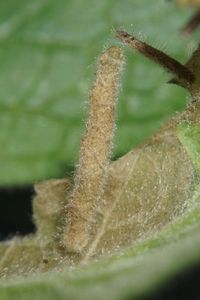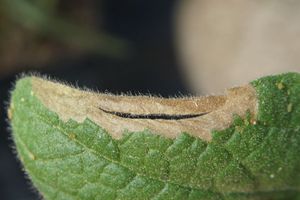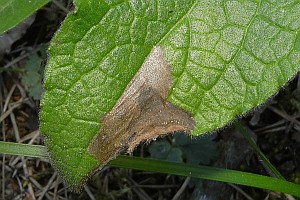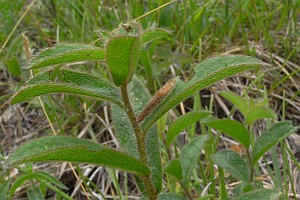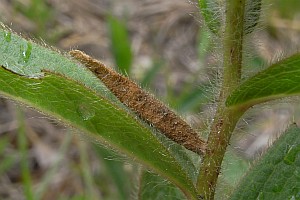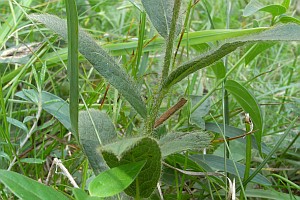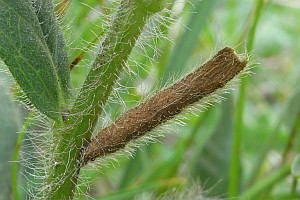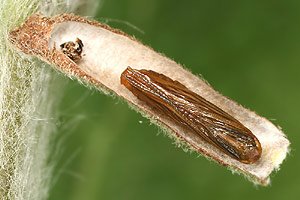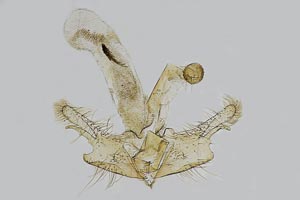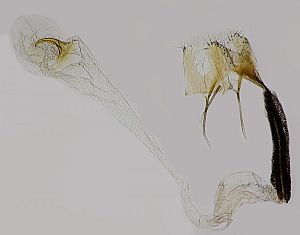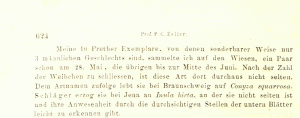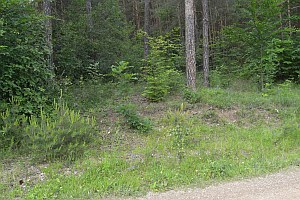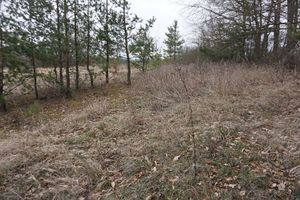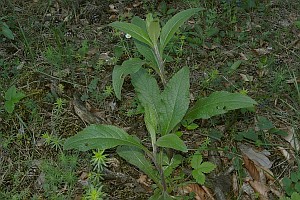

 +34Kontinente:EUASAF
+34Kontinente:EUASAF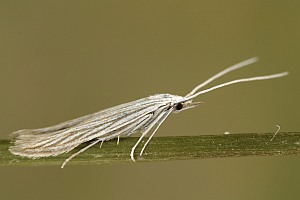
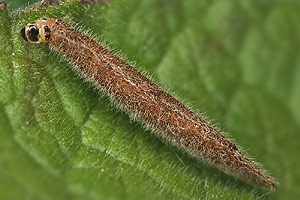
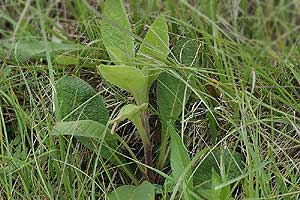
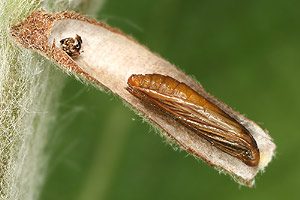


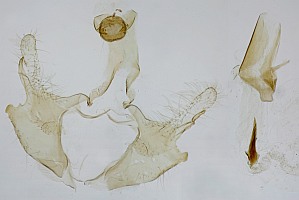
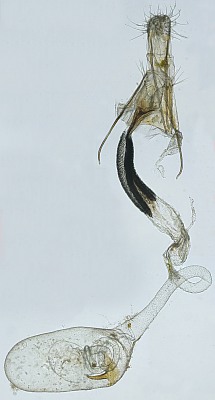
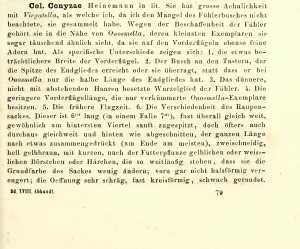
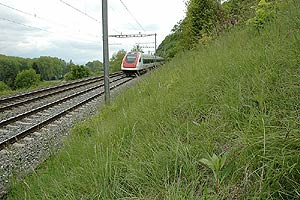
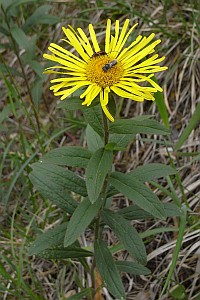
1. Lebendfotos
1.1. Falter
1.2. Raupe, Raupensack
Im Verlauf des Lebens fertigt sich eine Raupe offensichtlich mehrere Säcke an. Vom zu klein gewordenen Sack wird dann in den neuen, grösseren umgezogen. Ich fand im Mai drei unterschiedliche Grössenklassen: im Bild 3 der mittelgrosse, unterdessen verlassene und der grosse, neue, jetzt bewohnte Sack der nahezu erwachsenen Raupe. Erkennbar ist der abgetrennte vordere Blattrand, der jetzt als neuer Sack dient. Bevor der Blattrand von der Raupe abgetrennt worden ist, hat sie den Randbereich des Blattes durch Minenfrass ausgehöhlt. (Autor: Rudolf Bryner)
1.3. Fraßspuren und Befallsbild
1.4. Puppe
2. Diagnose
2.1. Weibchen
2.2. Geschlecht nicht bestimmt
2.3. Genitalien
2.3.1. Männchen
2.3.2. Weibchen
2.4. Erstbeschreibung
3. Biologie
3.1. Habitat
3.2. Raupennahrungspflanzen
3.3. Nahrung der Raupe
- [Asteraceae:] Pentanema conyzae [= Inula conyzae, Inula conyza, Conyza squarrosa] (Dürrwurz, Dürrwurz-Alant)
- [Asteraceae:] Pentanema hirtum [= Inula hirta] (Rauhaariger Alant, Rauer Alant, Rauher Alant)
- [Asteraceae:] Pentanema germanicum [= Inula germanica] (Deutscher Alant)
- [Asteraceae:] Pentanema ensifolium [= Inula ensifolia] (Schwert-Alant)
- [Asteraceae:] Pentanema oculus-christi [= Inula oculus-christi] (Christusaugen-Alant)
- [Asteraceae:] Pentanema salicinum [= Inula salicina] (Weiden-Alant)
- [Asteraceae:] Inula spiraeifolia (Sparriger Alant)
- [Asteraceae:] Pulicaria dysenterica (Flohkraut)
- [Asteraceae:] Eupatorium cannabinum (Wasserdost, Wasserhanf)
- [Rutaceae:] Ruta sp. ?? (Raute ??)
Die Raupen leben an verschiedenen Alant-Arten (Inula spp. s.l., heute Pentanema sp.). Schon in der Erstbeschreibung angeführt wurden "Conyza squarrosa" und "Inula hirta", die in Mitteleuropa seither mehrfach als Raupennahrung bestätigt wurden. Emmet et al. (1996: 251) erweitern dieses Spektrum für England deutlich: "Ovum. Laid beneath a leaf of ploughman's-spikenard (Inula conyza) or common fleabane (Pulicaria dysenterica); less often on hemp-agrimony (Eupatorium cannabinum) (Stainton, 1875)."
Baldizzone (2019: 139) listet auf: "Piante nutrici: Inula di varie specie (conyza, ensifolia, hirta, oculos-christi, salicina, spiraeifolia), Dittrichia viscosa, Eupatorium cannabinum, Pulicaria dysenterica (Asteraceae), Ruta sp. Rutaceae)." Letzteres soll nach auf Baldizzone (1990) zurückgehen: "On Crete larvae have been found on Ruta (Baldizzone, 1990b); for the moment this seems xenophagy." Alternativ könnte es sich um eine getrennte, noch zu beschreibende Art gehandelt haben. Auch bei den anderen Arten bleibt oft unklar, ob es hier Primärangaben über Freiland-Raupenfunde gibt oder "nur" Zuchtbeobachtungen vorliegen.
Budashkin (2011:26) meldet die Art ex larva von "Inula germanica" von der Krim.
Die Angabe zu "Inula viscosa" geht auf Hering (1936: 258) und dessen Raupenfunde von "Coleophora conyzae xenia" in Spanien zurück - da jenes Taxon heute als Synonym zu Coleophora solidaginella gilt, müssenen auch die Raupenangaben zu jener Art verschoben werden.
(Autor: Erwin Rennwald)
4. Weitere Informationen
4.1. Andere Kombinationen
- Orthographis conyzae (Zeller, 1868) [so bei Budashkin (2011: 26) und Sinev (2019)]
4.2. Synonyme
- Coleophora angustilinea Toll, 1962 [synonymisiert von Baldizzone (1982)]
- Coleophora mellechella Toll, 1962 [synonymisiert von Baldizzone (1982)]
- Kuznetzovvlia vicolii Nemeş, 2003 [synonymisiert durch Baldizzone (2005)]
4.3. Typenmaterial
Baldizzone (1994: 19) designierte einen Lectotypus: “Lectotypus ♂ [designato in questa sede] conservato al BMNH, reca le seguenti etichette: 1) “LECTOTYPE” (a stampa, rotondo, orlato di blu), 2) “Col. conyzae Hnm. lit. 1/65.” (a mano), 3) “Zeller Coll. Walsingham Collection, B.M. 1910-427” (a stampa), 4) “B.M. ♂ Genitalia slide Np. 11016” (a mano e stampa).”
4.4. Literatur
- Arbeitsgemeinschaft Microlepidoptera in Bayern (2025): Neue Ergebnisse in der bayerischen Kleinschmetterlingsfaunistik 13. Beitrag — Beiträge zur bayerischen Entomofaunistik 25: 121 – 133.
- Baldizzone, G. (1982): Contributi alla conoscenza dei «Coleophoridae» XXVII. Nuove sinonimie nel genere Coleophora Hübner (111 [sic, recte: III]) (Lepidoptera). — Rivista piemontese di Storia naturale 3: 145-161. [PDF auf islandlab.uac.pt]
- Baldizzone, G. (1990): Coleophoridae nuovi o poco conosciuti della fauna Greca. — Fragmenta entomologica, Roma, 22 (1): 39-59. [Sekundärzitat]
- Lectotypus-Festlegung: Baldizzone, G. (1994): Contribuzioni alla conoscenza dei Coleophoridae LXXV. Coleophoridae dell'Area Irano-Anatolica e regioni limitrofe (Lepidoptera). — Associazione Naturalistica Piemontese Memorie 3: 1-423. Stenstrup (Apollo Books).
- Baldizzone, G. (2005): Contribuzioni alla conoscenza dei Coleophoridae. CX. Alcune note sui Coleophoridae descritti da Ioan Nemeş negli anni 2003 e 2004 (Lepidoptera: Coleophoridae). — SHILAP Revista de Lepidopterología, 33 (130): 123-130. [PDF auf redalyc.org]
- Будашкин, Ю. И. (2011): Дополнения к фауне и биологии молей-чехлоносок (Lepidoptera, Coleophoridae) Крыма. — Экосистемы, их оптимизация и охрана Выпуск 5 (24): 21-36. [PDF auf cyberleninka.ru]
- Будашкин, Ю. И., Рихтер, И. & Ю. Табель (2015): Новые находки молей-чехлоносок (Lepidoptera: Coleophoridae) в России и в Армении. — Эверсманния 41: 11–22.
- Фалькович, М. И. (1988): К фауне чехлоносок (Lepidoptera, Coleophoridae) южной Туркмении (с описанием новых видов). — Труды Зоологического института Академия наук СССР 178: 134-162.
- Hering, M. (1936): Blattminen von Spanien. — Eos Revista española de entomologia 11 (4): 331-384, pl. XVI.
- Kayser, C. (2024): Ergänzungen zur Kleinschmetterlingsfauna Niedersachsens (2) (Microlepidoptera). — Melanargia 36 (3/4): 124-140.
- Richter, I. (2017): New findings of the case-bearing moth genus Coleophora from the Balkan Peninsula with the description of Coleophora vardarella sp. nov. (Lepidoptera: Coleophoridae). — Microlepidoptera.hu 12: 83-94. [PDF auf oszk.hu] bzw. [ganzes Heft: PDF auf oszk.hu]
- SCHÜTZE (1931): 199
- Синёв, С. Ю. [ed.] (2019): Каталог чешуекрылых (Lepidoptera) России. Издание второе [Sinev, S. Yu. (ed.) (2019): Catalogue of the Lepidoptera of Russia. Second edition]: 1-448.
- Tabell, J., Kullberg, J., Mutanen, M., Tokár, Z. & P. Sihvonen (2023): New and little known Coleophora Hübner, 1822 species from Morocco. Part I. (Lepidoptera, Coleophoridae). — Zootaxa 5374 (2): 151–195. [Zum PDF auf mapress.com]
- Erstbeschreibung: Zeller, P. C. (1868): Beitrag zur Kenntniss der Lepidoptern-Fauna der Umgegend von Raibl in Oberkärnthen und Preth im angrenzenden Küstengebiet. — Verhandlungen der kaiserlich-königlichen zoologisch-botanischen Gesellschaft in Wien 18: 563-628. [PDF auf zobodat.at]

































